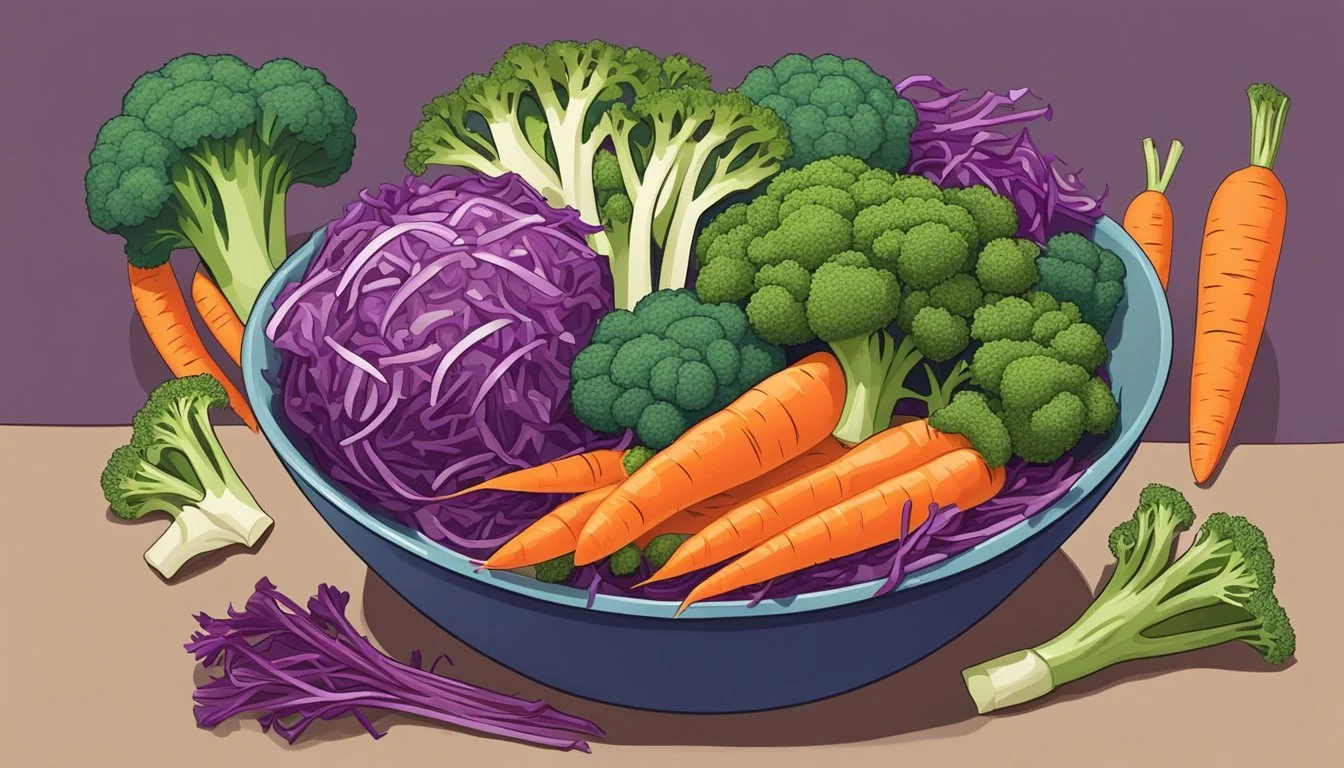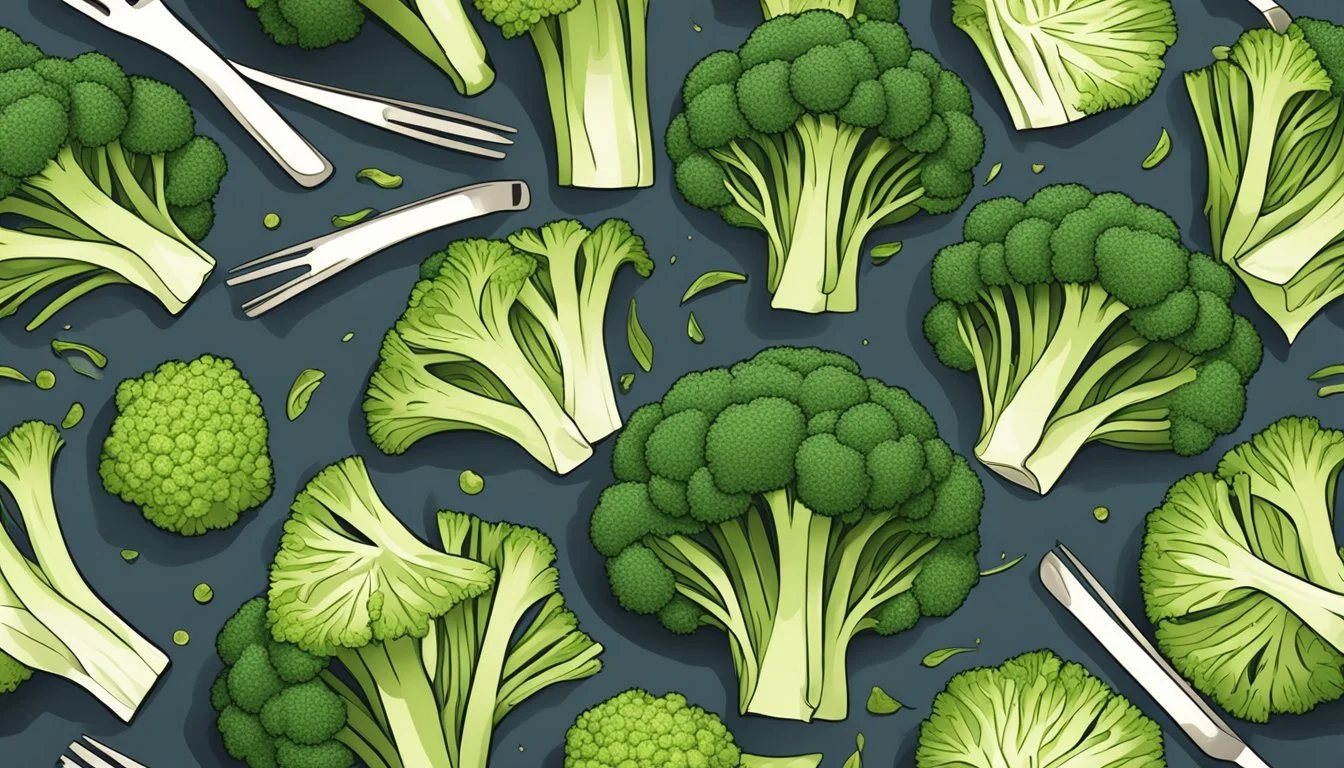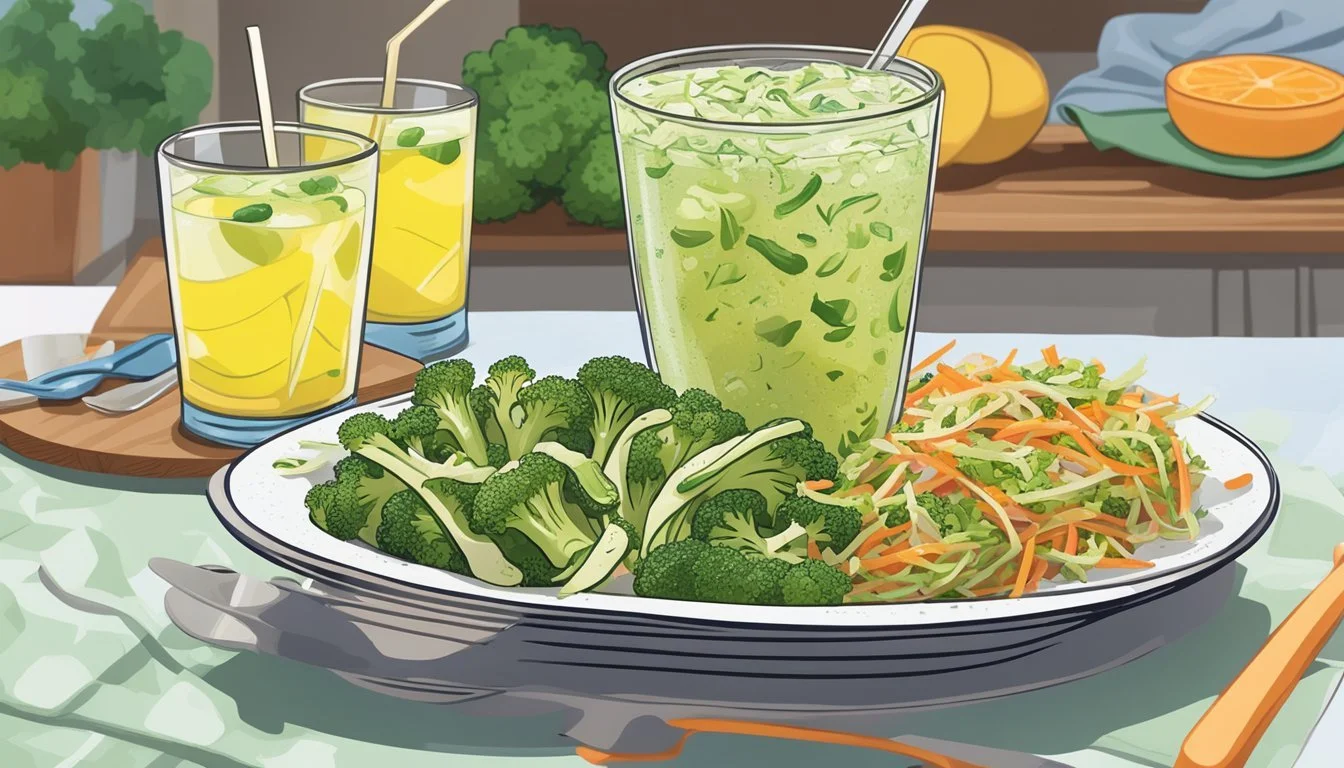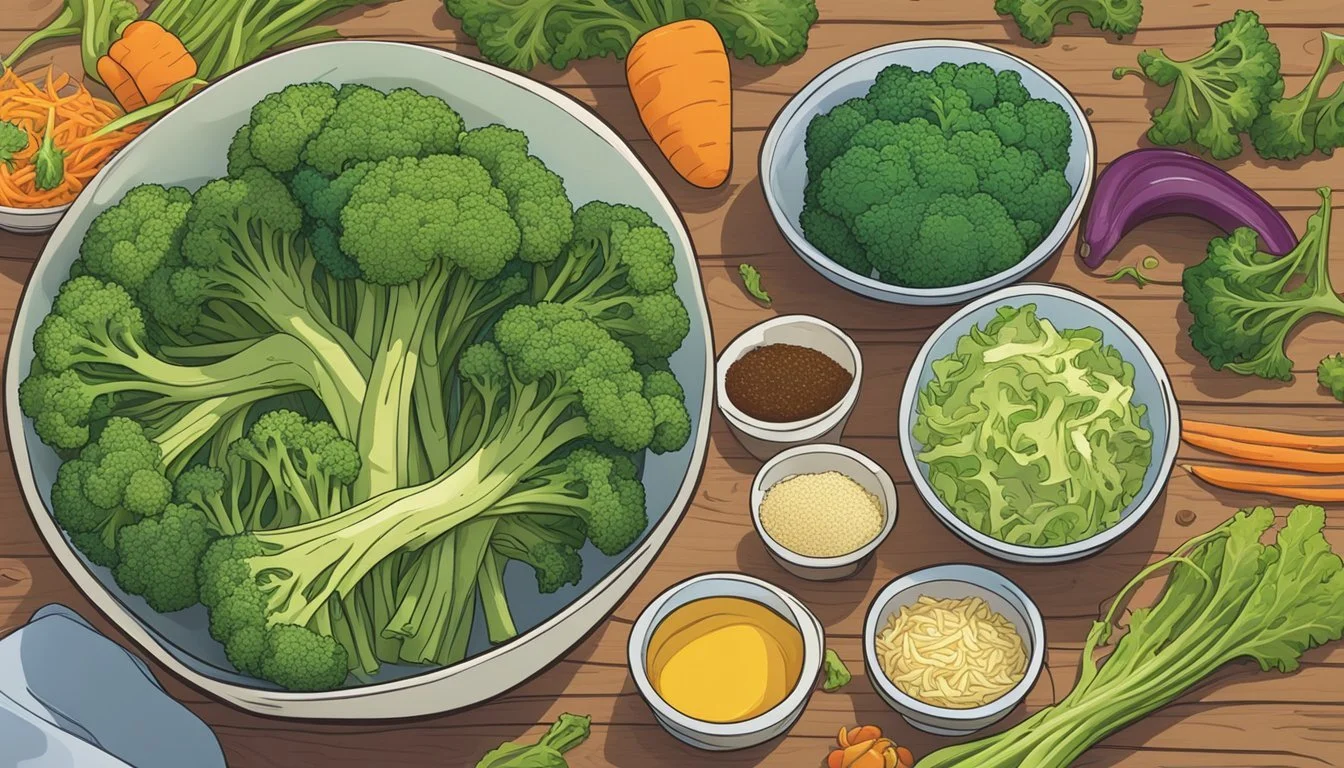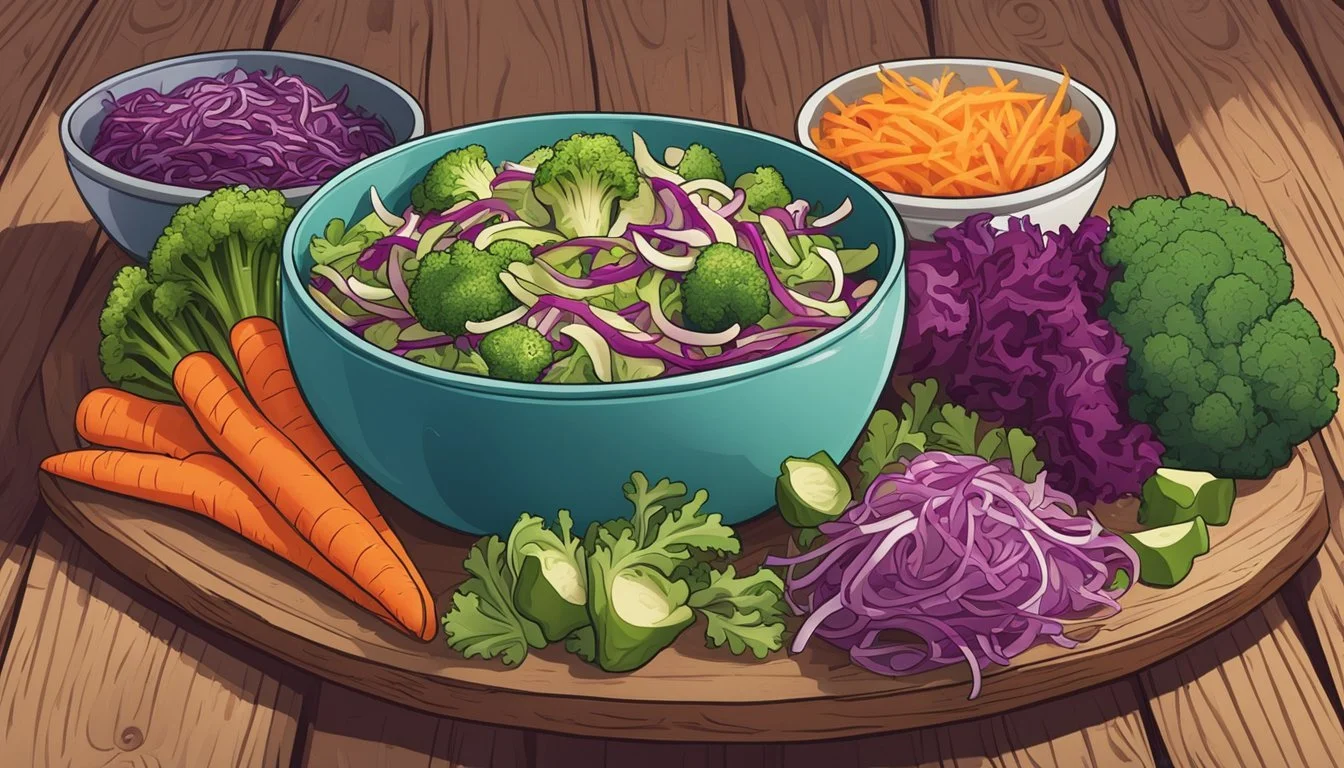Broccoli Stem Slaw
Delicious Ways to Enjoy a Nutrient-Rich Salad
Broccoli Stem Slaw is a vibrant and nutritious side dish that turns a commonly discarded part of broccoli into the star of the meal. Packed with a range of vitamins, minerals, and fiber, the broccoli stem is often overlooked in favor of its greener floret counterpart. Yet, this part of the vegetable is just as healthy and provides a delightful crunchy texture. The slaw is not only a testament to the versatility of broccoli but is also a testament to a sustainable approach to cooking, making use of the entire vegetable.
In crafting Broccoli Stem Slaw, chefs have found a creative way to infuse both health and flavor into their menus. This dish boasts a wholesome array of nutrients, including vitamin C, vitamin A, potassium, and folate, contributing to a well-balanced diet. The slaw's crunchy texture and ability to absorb a variety of dressings make it an appetizing addition to any table. Its crispness complements a wide range of main courses, from barbecued meats (What wine goes well with barbecued meats?) to vegetarian plates, enhancing the overall dining experience with both its taste and nutritional benefits.
Moreover, as a side dish, the Broccoli Stem Slaw offers a fresh take on traditional slaws that often rely on cabbage. It stands out not only for its health benefits but for its ease of preparation. By incorporating elements such as carrots, dried cranberries, and nuts, the slaw transforms into a colorful and appealing complement to meals that require little time to prepare. The inclusion of these ingredients not only contributes to the dish’s nutritional profile but also adds a variety of textures and flavors, ensuring that health-conscious eaters do not have to sacrifice taste for nutrition.
Nutritional Profile of Broccoli Stems
Broccoli stems are not just a crunchy addition to dishes; they are a treasure trove of vitamins, minerals, and essential nutrients beneficial to health.
Vitamins and Minerals Content
Broccoli stems are a rich source of various vitamins and minerals. They contain vitamin A, which is crucial for eye health, and a significant amount of vitamin C, essential for immune function. These stems provide potassium, which is vital for heart health, and folate, necessary for DNA synthesis and repair. Additionally, they have calcium for bone health and a notable supply of iron, essential for oxygen transport in the blood.
Vitamin A: important for vision and immune health.
Vitamin C: supports immunity and antioxidant protection.
Potassium: helps regulate blood pressure.
Folate: crucial for cellular function and tissue growth.
Calcium: key for strong bones and teeth.
Iron: necessary for red blood cell formation.
Fiber and Protein Counts
Broccoli stems are abundant in dietary fiber, contributing to digestive health and aiding in maintaining a healthy weight. They also contain some protein which is vital for building and repairing tissues.
Fiber: Helps to maintain digestive health.
Protein: Essential for the body's basic building blocks.
Caloric and Sugar Considerations
With low calories and sugar content, broccoli stems are an excellent food for those managing their caloric intake. They provide essential nutrients without the added sugars found in many other foods.
Low calories: Ideal for weight management.
Low sugar: Minimizes blood sugar spikes.
Health Benefits of Broccoli Stems
Broccoli stems offer a host of health benefits. They are rich in antioxidants like sulforaphane, which is linked to anti-inflammatory properties and may offer protection against certain cancers. The vitamin K content contributes to blood clotting and bone health. Furthermore, the high nutrient density of broccoli stems supports overall well-being with their anti-inflammatory properties, cholesterol-lowering fiber, and a blend of crucial minerals.
Antioxidants: protect cells from damage.
Vitamin K: essential for healthy blood and bones.
Anti-inflammatory: may reduce the risk of certain chronic diseases.
Cholesterol-lowering fiber: promotes heart health.
Minerals: overall support for body functions.
Ingredients for Broccoli Stem Slaw
Creating the perfect Broccoli Stem Slaw begins with the right ingredients. This guide ensures a balance of crunch, flavor, and nutrition.
Vegetable Selection
For the body of the slaw, one will need:
Broccoli stems: After peeling, sliced into matchsticks for a satisfying crunch.
Carrots: Grated for a pop of color and additional texture.
Cabbage: Shredded to add volume and complement the stems.
Kale and spinach: Optional, finely chopped for a nutrient-dense addition.
Cauliflower: Chopped into small pieces if desired for varied texture.
Dressing Components
A dressing binds the slaw together and enhances its flavors:
Greek Yogurt or mayonnaise: A base providing creaminess.
Olive oil: Adds a smooth, rich taste.
Lemon juice or apple cider vinegar: For a bright, tangy note.
Dijon mustard: A small amount to emulsify and add a tangy kick.
Salt and pepper: Essential seasoning to taste.
Additional Flavor Enhancers
These ingredients elevate the slaw to the next level:
Seeds: Sunflower or pumpkin seeds for crunch.
Garlic and ginger: Minced, for depth of flavor.
Apple: Thinly sliced for a sweet contrast.
Step-by-Step Slaw Recipe
This section provides a straightforward approach to creating a delicious Broccoli Stem Slaw. The recipe focuses on utilizing the often-discarded broccoli stems, transforming them into a nutrient-rich, crunchy side dish that can accompany any main course.
Preparation of Vegetables
The first step is to properly prepare the broccoli stems. Ingredients you will need are:
Broccoli stems
Carrots (optional for added color and texture)
Green onions (optional for a zesty flavor)
Begin by thoroughly washing the broccoli stems.
Use a peeler or a sharp knife to remove the tough, fibrous outer layer of the broccoli stems.
Slice the peeled stems into thin planks, then cut them into matchsticks. Optionally, you can add grated carrots and chopped green onions for more variety and flavor.
Combining Ingredients
To assemble the slaw, gather the julienned broccoli stems and any additional vegetables you've prepared.
Add the julienned stems, grated carrots, and green onions to a large bowl.
Toss the vegetables to ensure an even mix.
Dressing Application
The slaw dressing is what will tie all the ingredients together. For the dressing, you will need:
Mayonnaise or a vegan alternative
Apple cider vinegar
Honey or a sweetener of choice
Mustard (Dijon mustard is preferred for its tangy flavor)
Salt and pepper for seasoning
Whisk together mayonnaise, vinegar, honey, and mustard in a separate small bowl.
Season with salt and pepper to your liking.
Pour the dressing over the vegetable mixture, ensuring all pieces are evenly coated.
Toss the slaw once more to distribute the dressing thoroughly. The slaw is now ready to serve as a complementary side to your main course, offering both a textural contrast and a boost of vitamins.
Serving Suggestions and Pairings
Broccoli stem slaw is a versatile side dish that pairs excellently with a variety of proteins and can be served in numerous ways. Its crisp texture and nutrient-rich profile make it an appealing addition to any meal.
Accompaniments
Broccoli stem slaw complements a range of proteins, enhancing the overall meal with its vibrant mix of flavors and textures. For a classic pairing, it goes particularly well with grilled chicken, letting its subtle flavors shine. For seafood lovers, tuna steaks (What wine goes well with tuna steak?) offer a rich, meaty counterpoint to the slaw's crunch. Vegetarians might prefer a hearty slab of grilled tofu (What wine goes well with grilled tofu?), which can absorb the slaw's dressing, adding depth. Adding cheese, such as feta or goat cheese, introduces a creamy tang that contrasts nicely with the slaw.
Proteins to Pair With:
Chicken (grilled or roasted)
Tuna (grilled or seared)
Tofu (grilled or pan-fried)
Cheese (crumbled feta or goat cheese)
Alternative Serving Modes
Broccoli stem slaw can brighten up not just in flavor but also in presentation. Incorporating colorful vegetables like red cabbage or thinly sliced zucchini adds a burst of color and enhances the nutrient profile. The slaw can easily double as a filling for wraps or as a garnish atop sandwiches, playing an exciting role in the meal's texture dynamics.
Ways to Serve:
As a standalone side dish
In wraps or sandwiches for added crunch
Mixed with colorful veggies like red cabbage or zucchini for a more vibrant dish
Customizing Your Slaw
Creating a broccoli stem slaw that caters to diverse dietary needs and personal tastes is both simple and gratifying. By substituting specific ingredients, one can easily craft a slaw that is vegetarian, vegan, gluten-free, or dairy-free without compromising the dish's crunchy texture and rich vitamin content.
Vegetarian and Vegan Options
For vegetarian options, one can incorporate a variety of non-meat proteins such as nuts or seeds, ensuring the dish remains hearty and nutritious. To adapt the slaw for a vegan diet, traditional mayonnaise—which contains eggs—can be replaced with vegan mayo made from plant-based ingredients. Dairy-based ingredients common in some slaw dressings, like yogurt, can be replaced with dairy-free alternatives, such as soy, almond, or coconut-based products. Adding a rich depth of flavor can be achieved with sesame oil, which is both vegan and vegetarian-friendly.
Protein Add-ins:
Nuts: Almonds, walnuts
Seeds: Sunflower seeds, pumpkin seeds
Vegan Mayo Brands:
Just Mayo
Vegenaise
Adjusting for Dietary Restrictions
Individuals with gluten sensitivities can create a gluten-free slaw by opting for dressings that are free from ingredients like soy sauce, which often contains wheat. Instead, tamari—a gluten-free soy sauce alternative—can be used. For those avoiding dairy, as mentioned, dairy-free yogurt can serve as a great substitute in creamy dressings. To ensure the slaw aligns with all dietary restrictions, always check the labels for hidden sources of gluten, dairy, and other common allergens.
Gluten-Free Options:
Gluten-free tamari
Certified gluten-free dressings
Dairy-Free Substitutes:
Dairy-free yogurt (soy, almond, coconut)
Dairy-free cheese shreds for garnish
Food Safety and Storage
When preparing broccoli stem slaw, it's essential to consider food safety and storage to maintain the dish's quality and nutritional value. Proper refrigeration and handling ensure the slaw remains safe to consume and delicious.
Refrigeration and Shelf Life
Broccoli stem slaw should be stored in the refrigerator at a temperature below 40°F (4°C) to limit the growth of harmful bacteria. The shelf life of prepared slaw is typically 3 to 5 days when kept in a sealed container. It’s also helpful to note the date when the slaw was made for better tracking.
Refrigeration Temperature: Below 40°F (4°C)
Shelf Life: 3 to 5 days
Container: Airtight and sealed
Best Practices for Leftovers
For any leftover broccoli stem slaw, it is crucial to handle it with care to extend its usability and retain its nutrition.
Cooling Down: Before refrigerating leftovers, allow the slaw to cool to avoid warming other foods.
Sealing Properly: Transfer the slaw into an airtight container to prevent moisture loss and the absorption of other food flavors.
Re-serving: Use clean utensils each time to serve the slaw to prevent the introduction of bacteria.
By following these guidelines, diners can ensure the broccoli stem slaw they consume is not only fresh and crunchy but also safe and nutritionally intact.
Health Considerations
Broccoli stem slaw is not only a flavorful addition to meals but also comes with various health considerations that are important for maintaining a balanced diet.
Impact on Blood Sugar
Broccoli slaw, composed predominantly of raw broccoli stems and other vegetables, is low in sugar and calories, making it a favorable side dish for blood sugar management. It has a low glycemic index, which implies that it doesn't cause rapid spikes in blood sugar levels. This characteristic is particularly beneficial for individuals with diabetes or those monitoring their blood sugar.
Role in Heart Health
The ingredients in broccoli stem slaw contribute to heart health through different mechanisms. Broccoli is known for its high fiber content, which can help to maintain healthy cholesterol levels. Moreover, the presence of antioxidants, vitamins, and minerals like Vitamin C and manganese supports cardiovascular health by fighting inflammation and oxidative stress that can lead to heart disease.
Diet and Weight Management
Broccoli stem slaw, being nutrient-dense and low in calories, is an excellent option for those pursuing weight management or a healthy diet. It provides satiety with minimal caloric intake, which is helpful in preventing overeating. The fiber content not just helps in managing appetite but also aids in digestion and metabolism, making it an ally against obesity and promoting nutritional well-being.
Culinary Context
Broccoli stem slaw, a refreshing and crunchy salad, makes an excellent side dish known for its versatility in pairing and variations. The slaw's ingredients are not only nutritious but also adaptable to different culinary traditions and beverage matchings.
Pairing with Beverages
Broccoli slaw pairs well with a diverse range of beverages that complement its crisp texture and tangy flavor profile. For a non-alcoholic option, iced lemon water is ideal, as the citrus notes enhance the slaw's brightness, benefiting from the inclusion of lemon juice in the dressing. In terms of wine, a light-bodied white wine such as Sauvignon Blanc balances the slaw's acidity, especially if honey or a similar sweetener is used to temper the dressing. For those who enjoy Asian-inspired variations, which might include ingredients like soy sauce or ginger, a light and crisp Asian lager can serve as a clean accompaniment.
Beverage Pairings:
Iced lemon water
Sauvignon Blanc
Asian lager
Cultural Variations of Slaw
The term "slaw" refers to shredded or chopped salads that often contain cabbage or broccoli stems. While most people might think of slaw as having a creamy dressing, cultural variations abound. In some Asian-inspired versions, broccoli slaw may skip the cream in favor of a vinaigrette made with ingredients like sesame oil, rice vinegar, and a sweetener such as honey, turning it into an accompaniment for dishes such as stir-fry. Additionally, some cultural interpretations integrate local flavors and ingredients, which can influence the choice of dressing acidity, sweetness, and overall flavor balance in the slaw.
Key Cultural Variations:
Creamy dressing (Traditional)
Sesame oil and rice vinegar vinaigrette (Asian-inspired)
Local ingredients and flavors (Regional adaptations)
Tips for Growing and Harvesting Broccoli
Broccoli is a versatile cruciferous vegetable that provides not only a rich source of vitamins in its florets but also in its stems. Proper growth and harvesting techniques can ensure a bountiful supply of this nutritious green.
Optimal Conditions for Growth
To cultivate broccoli successfully, gardeners should aim to provide optimal growing conditions. Broccoli thrives in cooler temperatures, preferably between 65°F and 70°F (18°C and 21°C). It is essential to maintain consistent soil moisture without waterlogging. This cruciferous vegetable favors a garden environment with full sunlight to partial shade and well-drained, fertile soil with a slightly acidic to neutral pH.
Temperature: Keep between 65°F - 70°F (18°C - 21°C)
Sunlight: Full to partial shade
Soil: Fertile, well-drained, pH 6.0 - 7.0
Moisture: Consistent, not waterlogged
Techniques for Harvesting Broccoli Stems
When it comes to harvesting broccoli, precise timing and technique are crucial. One should harvest the central head while it is tight, green, and before any flowers start to bloom. After cutting the main head, the plant will continue to produce smaller side shoots, which can be harvested regularly. For the stems, which are the main ingredient for broccoli stem slaw, use a sharp knife to cut them from the plant, then peel off the tough outer layer to reveal the tender core suitable for slaw.
Harvest central head before flowers bloom
Cut with a sharp knife
Peel for tender stems suitable for slaw
It's important to note that broccoli plants can offer multiple harvests. After the main head is harvested, one can reap the benefits of home-grown broccoli for an extended period by regularly harvesting the side shoots. This continuous harvesting can stimulate further growth and yield an extended harvest from each plant.
The Broccoli Family and Its Variants
The broccoli family, known as cruciferous vegetables, includes a variety of nutrient-rich options. These vegetables are celebrated for their health benefits, which include potential cancer-fighting properties.
Comparison of Cruciferous Vegetables
Cruciferous vegetables encompass a broad family that includes not only broccoli but also cauliflower, kale, brussels sprouts, and cabbage. They are known for their distinctive flavors and health-promoting compounds. Here is a brief comparison:
Broccoli: Rich in vitamins C and K, fiber, and compounds like glucosinolates.
Cauliflower: Offers a milder taste and is versatile in cooking; contains antioxidants and phytonutrients.
Kale: Loaded with vitamins A, C, and K; extremely high in beta-carotene.
Brussels Sprouts: Small, tightly packed green buds known for their nutty flavor; high in fiber, vitamins, and minerals.
These vegetables can be enjoyed raw or cooked, with cooking methods such as steaming or roasting often enhancing their natural crunchy texture while retaining their colorful appearance and nutritional content.
Unique Characteristics of Broccoli
Broccoli stands out in the cruciferous family for several reasons. It has robust stalks with a combination of dark green leaves and florets, offering a versatile ingredient for a range of dishes. When it comes to slaws or salads, the stems of broccoli, often discarded, are just as nutritious as the florets. They are high in fiber, vitamins C and K, and iron, making them excellent for crunchy side dishes like broccoli stem slaw. Their hearty texture holds up well in both raw applications and when subjected to the cooking process.
Addressing Common Myths
When it comes to Broccoli Stem Slaw, there's an abundance of misinformation circulating around its health impact, particularly on thyroid health, and how cooking methods affect its nutrient content. This section dispels common myths with factual clarity.
Broccoli and Thyroid Health
A prevailing myth suggests that cruciferous vegetables like broccoli can interfere with thyroid function. While it's true that these vegetables contain goitrogens, which have the potential to disrupt thyroid hormone production, the impact is minimal for individuals with normal thyroid function when consumed in reasonable amounts. Cooking also considerably reduces the goitrogenic compounds. Moderate consumption of Broccoli Stem Slaw, even among those monitoring thyroid health, is typically not a concern.
Misconceptions About Cooking Methods
Myths pertaining to the best cooking methods to preserve nutrients in broccoli slaw are widespread. Boiling is often associated with a significant loss of vitamins and minerals. However, since Broccoli Stem Slaw is generally served raw or lightly cooked to maintain its crunchiness, it retains most of its nutrient content, including vitamin C and sulforaphane. There's a misconception that grilling is a superior method to preserve nutrients, yet grilling could char the broccoli, affecting its taste and nutrient profile. The truth is that incorporating broccoli stems raw into a slaw maximizes nutrient retention.
Enhancements and Alternative Uses
Broccoli stem slaw is versatile, rich in vitamins, and can transform ordinary dishes into a flavorful and nutritious experience.
Broccoli Slaw as a Topping
Broccoli stem slaw makes an excellent topping due to its satisfying crunch and nutritional density. It can be sprinkled on top of sandwiches to add a burst of freshness and texture. A hint of grated parmesan cheese complements the earthy flavors and provides a savory boost. Combining the slaw with red pepper flakes introduces a subtle heat that can elevate a variety of dishes from tacos to grilled fish.
Sandwiches: A layer of broccoli slaw adds a crunchy texture.
Tacos/Nachos: A garnish that lends freshness and a healthful twist.
Grilled Foods: Complements smoky flavors with its crispness.
Creative Cooking Ideas
Culinary innovation shines when one incorporates broccoli stem slaw into various cooking concepts. Asian-inspired dressing, for example, gives slaw a tangy, sweet, and umami-packed profile, contrasting beautifully against the slaw's natural bitterness. One can get creative with slaw by integrating it into stir-fries or as a base for a veggie-packed salad. The key is to keep the slaw as a fundamental element that enhances overall flavor and texture.
Asian-Inspired Stir-Fries: Toss in slaw for added crunch and nutrients.
Veggie-Packed Salads: Use slaw as a base and toss with a vibrant dressing.
Innovative Parings: Pair with fruit or nuts for unexpected taste combinations.
Broccoli Stem Slaw in Diets
Broccoli stem slaw can be an excellent addition to various diet plans, providing a crunch rich in nutrients while keeping carbohydrate and sodium levels in check. It fits well within keto and low-carb diets and serves as a versatile side in balanced dietary approaches.
Keto and Low-Carb Approaches
Broccoli stems, unlike many other starchy vegetables, are low in carbohydrates, making them an ideal ingredient for someone on a keto or low-carb diet. A typical serving of broccoli stem slaw contains:
Carbohydrates: Roughly 4-7 grams per cup
Fiber: Approximately 2-3 grams per cup
The fiber content is particularly important as it can help to reduce the net carbohydrate count, which is a crucial consideration for ketogenic diets. When preparing broccoli stem slaw for these diets, it’s important to create a dressing that is low in carbs. This means using mayonnaise or Greek yogurt with no added sugars, and opting for a sweetener alternative, if needed, like stevia or erythritol.
Incorporating Slaw into Balanced Diets
Incorporating broccoli stem slaw into a balanced diet enhances overall nutrition by providing essential vitamins and minerals, such as vitamin C, calcium, and iron. A balanced diet aims to have a variety of foods in moderation, and broccoli stem slaw adds both texture and nourishment without overloading on calories. It can be seasoned to taste without adding excess sodium, making it a heart-healthy choice.
For those concerned about balanced diet principles:
Calories: Typically low, enabling inclusion in a calorie-controlled diet
Nutrition: Rich in dietary fiber, vitamin C, calcium, and iron
To maximize the nutritional benefits of broccoli stem slaw within a balanced diet, it is advised to mix the broccoli stems with other colorful vegetables such as carrots or red onion, and use homemade dressings to control the amount of added sodium and preservatives.

